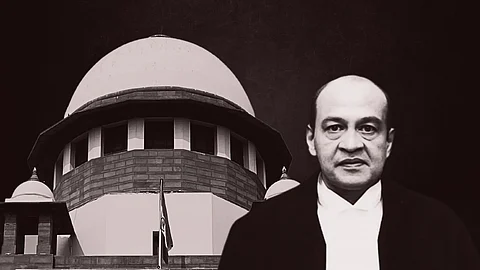

THE SUPREME COURT TODAY dismissed a petition filed by Justice Yashwant Varma of the Allahabad High Court challenging the recommendation for his removal by the then Chief Justice of India Sanjiv Khanna, along with the constitution of an in-house inquiry committee and the procedure it followed in probing the alleged recovery of a large sum of semi-burnt bundles of unaccounted cash from his official residence in Delhi.
The court underscored that the Chief Justice of India, as head of the judiciary, is morally, ethically, and legally empowered to take necessary steps to safeguard the institutional integrity of the judicial system when informed of serious misconduct by a judge.
A bench comprising Justices Dipankar Datta and Augustine George Masih upheld the constitutionality and legality of the in-house inquiry process initiated by then CJI Khanna, which began with the formation of a three-judge committee and concluded with a May 8 communication to the President and Prime Minister recommending Justice Varma’s removal.
“The CJI, as the leader of the judiciary, apart from his various other duties owes a duty to the people of the country to keep the justice delivery system pure, clean and unpolluted,” Justice Datta said speaking for the court, “It is unreasonable to even think that despite an incident of the present nature, the CJI would wait for the Parliament to take action. As observed before, it is up to the Parliament whether or not to activate Article 124.”
Endorsing the action taken by the then CJI, the judgment further said, “Left to him, the CJI upon being informed of a Judge’s remissness does have the authority – moral, ethical and legal – to take such necessary action as is warranted to keep institutional integrity intact. Any adverse impact on the credibility of the institution could prove dear.”
Finding no legal infirmity in the CJI’s May 8 communication, the bench upheld the forwarding of the committee’s report and recommendation to the President and Prime Minister, stating:
“It is keeping in view such concerns and the legal position of the President being the ultimate appointing authority of judges and the Prime Minister being the head of the Council of Ministers, upon whose aid and advice the President acts under our Constitution, coupled with receipt of complaints from the office of the President that we find the provision in paragraph 7(ii) of the PROCEDURE requiring the CJI to write to the President and the Prime Minister along with the report of the Committee to be quite in order, legal and valid. We repeat, the office of the CJI is not to be regarded as a post office that the report should only be routed through the CJI without his observations.”
Delivering the judgment, Justice Datta noted, “We have held that the CJI and the in-house committee had scrupulously followed the process, except the uploading of photos and videos, which we have held was not required. Nothing turns on that omission because you (Justice Varma) did not challenge it at that stage.”
The bench clarified that while the petition had been dismissed, Justice Varma retained the liberty to pursue legal remedies in future, should circumstances warrant.
The case stemmed from a March 14 incident in which Delhi Fire Service personnel, responding to a blaze at Justice Varma’s then-official residence, allegedly recovered a large stash of partially burnt, unaccounted cash. This prompted the initiation of an in-house inquiry by a three-judge committee set up by then CJI Khanna. Justice Varma subsequently challenged the constitution of the committee, the procedure followed, and the recommendation for his removal.
Adjudicating his petition, the Supreme Court framed six questions:
Whether the writ petition was maintainable in light of the petitioner’s conduct;
Whether the in-house procedure had legal sanction;
Whether such an inquiry and report constituted a parallel and extra-constitutional mechanism;
Whether paragraph 5(b) of the Procedure violated Articles 124, 125, 217 and 218 or any fundamental rights;
Whether the CJI and committee acted within the bounds of the procedure; and finally,
Whether paragraph 7(ii), which mandates forwarding the report to the executive, was unconstitutional.
The judgment held that the in-house procedure enjoys legal sanctity and does not operate as a parallel system to the constitutional impeachment process. It found no violation of Justice Varma’s fundamental rights and affirmed that both the CJI and the inquiry committee had acted within their authority. The uploading of photos and videos, though not required, did not impact the validity of the process, especially since Justice Varma did not object to it at the time. It was also noted that Justice Varma appeared before the inquiry committee.
Rejecting the contention that forwarding the report to the President and Prime Minister was improper, the Court ruled it was “well within the bounds of propriety and due process.”
With this decision, the top Court has reaffirmed the validity and institutional integrity of the judiciary’s in-house mechanism for probing judicial misconduct. It also emphasized adherence to due process while leaving the door open for further challenge should compelling grounds arise.